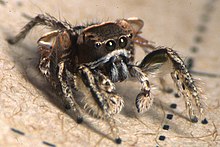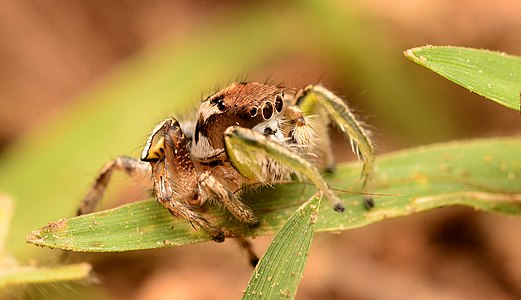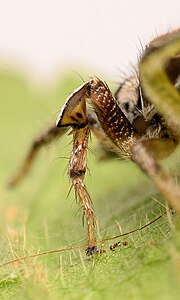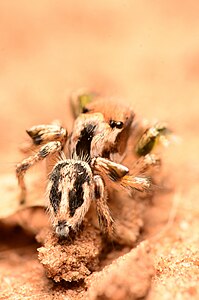
Jumping spiders are a group of spiders that constitute the family Salticidae. As of 2019, this family contained over 600 described genera and over 6,000 described species, making it the largest family of spiders at 13% of all species. Jumping spiders have some of the best vision among arthropods and use it in courtship, hunting, and navigation. Although they normally move unobtrusively and fairly slowly, most species are capable of very agile jumps, notably when hunting, but sometimes in response to sudden threats or crossing long gaps. Both their book lungs and tracheal system are well-developed, and they use both systems. Jumping spiders are generally recognized by their eye pattern. All jumping spiders have four pairs of eyes, with the anterior median pair being particularly large.
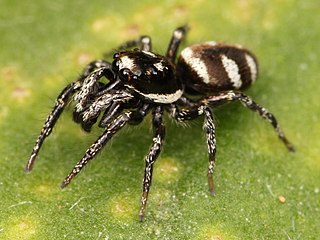
The zebra spider is a common jumping spider of the Northern Hemisphere. Their common name refers to their vivid black-and-white colouration, whilst their scientific name derives from Salticus from the Latin for “jump”, and the Greek scenicus, translating to “theatrical” or “of a decorative place,” in reference to the flashy, zebra-like coloration of the species.

Habronattus is a genus in the family Salticidae. Most species are native to North America. They are commonly referred to as paradise spiders due to their colorful courtship ornaments and complex dances, similar to birds-of-paradise. Males display intricate coloration, while females are cryptic.

Phidippus audax, the bold jumper or bold jumping spider, is a common species of spider belonging to the genus Phidippus, a group of jumping spiders easily identified by their large eyes and their iridescent chelicerae. Like all jumping spiders, they have excellent stereoscopic vision that aids them in stalking prey and facilitates visual communication with potential mates during courting. Bold jumping spiders are native to North America and have been introduced to Hawaii, Nicobar Islands, Azores, and the Netherlands. They are typically black with a distinct white triangle on their abdomen.

Diaea dorsata is one of the smaller crab spiders, with a palearctic distribution. Females can grow up to 6 mm, males up to 4 mm. Prosoma and legs are green, the opisthosoma is yellowish with a brown mark.
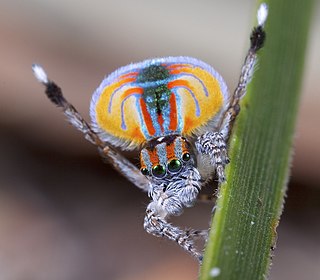
Maratus volans is a species in the jumping spider family (Salticidae), belonging to the genus Maratus. These spiders are native to certain areas in Australia and occupy a wide distribution of habitats. They have a specialized visual system that allows them to see the full visible spectrum as well as in the ultraviolet-range; this helps them detect and pursue prey. Males of this species are characterized by their colourful abdomen flaps that are used to attract females during courtship.

Phidippus californicus is a species of jumping spider. It is found in the southwestern United States and northern Mexico.

Saitis barbipes is a common jumping spider found in the Mediterranean region.

Maevia inclemens or the dimorphic jumping spider is a relatively common and colorful jumping spider of North America. In the males there are two forms, a very rare phenomenon in zoology. These use different courting displays, and differ in appearance: the "tufted" morph has a black body and pedipalps ("palps"), three black tufts across its "head", and pale legs; and the "gray" morph has black and white stripes all over its body and legs, orange palps, and no tufts. However, each form accounts for 50% of the adult males, and they are equally successful in mating. A female of Maevia inclemens is 6.5 to 8.0 millimetres long, while males are 4.75 to 6.50 millimetres long.

Bagheera kiplingi is a species of jumping spider found in Central America, including Mexico, Costa Rica, and Guatemala. It is the type species of the genus Bagheera, which includes three other species, including B. prosper. B. kiplingi is notable for its peculiar diet, which is mostly herbivorous. No other known species of omnivorous spider has such a markedly herbivorous diet.
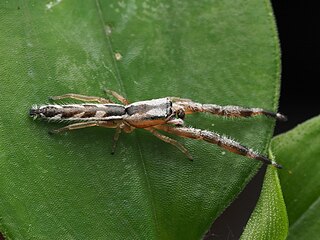
Marpissa pikei is a species of jumping spider that is found in the eastern United States, Texas, New Mexico, Arizona and Cuba.

Habronattus clypeatus is a species of jumping spider which occurs in the United States and Mexico. Its range extends from the southern Rocky Mountains to the northern Sierra Madre Occidental and Sonoran Desert. It belongs to the viridipes species group within the genus Habronattus.

Habronattus americanus is a species of jumping spiders from the family Salticidae.
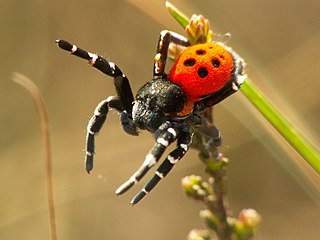
Sexual selection in spiders shows how sexual selection explains the evolution of phenotypic traits in spiders. Male spiders have many complex courtship rituals and have to avoid being eaten by the females, with the males of most species surviving only a few matings and consequently having short life-spans.

Habronattus pyrrithrix is a species of jumping spider in the family Salticidae. It is found in the southwestern United States and western Mexico.

Habronattus cognatus is a species of spider in the family Salticidae. It is found in North America.

Habronattus mataxus is a species of jumping spider found in Texas and northern Mexico.
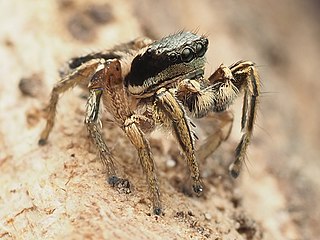
Habronattus mexicanus is a species of jumping spider in the genus Habronattus. The species was first identified in 1896 in Mexico, after which it is named, originally allocated to the genus Habrocestum. The species has subsequently been identified in locations in North and Central America, as well as islands in the Caribbean Sea. The spider is small, but displays one of the most complex sexual displays, including sophisticated vibatory song patterns.

Habronattus orbus is a species of jumping spider in the family Salticidae. It is found in the United States.

Habronattus texanus is a species of jumping spider in the family Salticidae. It is found in the United States and Mexico.
